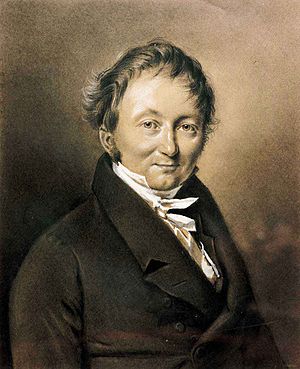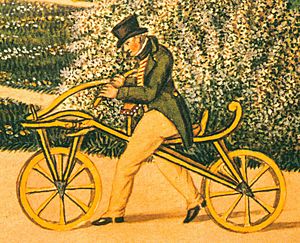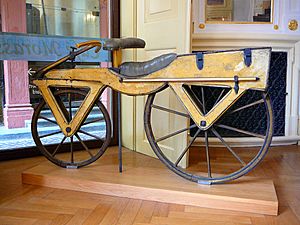Karl Drais facts for kids
Quick facts for kids
Karl Freiherr von Drais
|
|
|---|---|

Karl Drais, c. 1820, then still a baron
|
|
| Born |
Karl Friedrich Christian Ludwig Freiherr Drais von Sauerbronn
29 April 1785 |
| Died | 10 December 1851 (aged 66) Karlsruhe, Baden-Württemberg, Germany
|
| Nationality | German |
| Occupation | Inventor |
Karl Freiherr von Drais (born Karl Friedrich Christian Ludwig Freiherr Drais von Sauerbronn) was a German inventor. He was born on April 29, 1785, and died on December 10, 1851, both in Karlsruhe, Germany. Karl Drais is often called "the father of the bicycle" because of his amazing inventions.
Contents
The First Bicycle
Karl Drais was a very creative inventor. His most famous invention was the Laufmaschine, which means "running machine." People also called it the velocipede, draisine, or dandy horse. This machine was the very first two-wheeler, and it led to the modern bicycle and motorcycle. It was a bike without pedals!
His first recorded ride happened on June 12, 1817. He rode his Laufmaschine about 7 kilometers (4.3 miles) from Mannheim to a place called "Schwetzinger Relaishaus." The whole trip, going there and back, took him a little over an hour. This ride was a huge step for personal transport without horses.
However, there was a problem. The roads back then were very bumpy because of horse-drawn carriages. It was hard to keep balance on the Laufmaschine for a long time. So, riders started using the sidewalks, but they went too fast and put people walking in danger. Because of this, many places like Germany, Great Britain, and the United States banned the machine. This made it less popular for many years.
Other Cool Inventions
Karl Drais didn't just invent the bicycle! He also created many other useful things:
- The first typewriter with a keyboard in 1821.
- An early stenograph machine (for fast writing) in 1827.
- A device to record piano music on paper in 1812.
- The first meat grinder in the 1840s.
- A special cooker that saved wood, including an early hay chest.
He also invented two human-powered vehicles with four wheels in 1813 and 1814. One of these he showed in Vienna after Napoleon's defeat. In 1842, he made a foot-driven railway vehicle. Today, railway handcars are still called "draisine" because of him!
Life as a Public Servant
Karl Drais worked for the government of Baden, even though he wasn't actively working. This meant he couldn't make money from his inventions. So, in 1818, the Grand Duke Karl gave him a special permission to protect his inventions for 10 years. The Duke also gave him an honorary title: professor of mechanics. This was just a title, not a job at a university. Later, Drais retired from his government job and received a pension (regular payments) for his work.
Challenges and Later Life
Karl Drais faced some tough times. He strongly believed in new ideas and supported a big change in government in 1822. Because of his family connections to a judge who made an unpopular decision, some students were angry with him.
To avoid trouble, Drais moved to Brazil and lived there from 1822 to 1827. He worked as a land surveyor. When he returned to Germany, he faced more challenges from people who were jealous of him.
In 1839, after a dangerous situation in 1838, he moved to a village called Waldkatzenbach. He stayed there until 1845, and during this time, he invented the railway handcar. Finally, he moved back to his hometown of Karlsruhe.
In 1849, still believing in big changes, Drais gave up his noble title of Baron. He wanted to be known as "Citizen Karl Drais." After the revolution he supported failed, he was in a difficult spot. Some royalists tried to say he was mentally ill. His pension was taken away to pay for the "costs of revolution."
Death and Legacy
Karl Drais died without money on December 10, 1851, in Karlsruhe. The house where he lived was very close to where a young Carl Benz, who later invented the first automobile, grew up.
Karl Drais is remembered for his amazing contributions to transport and technology.
- In 1985, West Germany made a special postage stamp to celebrate his 200th birthday.
- On April 29, 2010, Google honored his 225th birthday with a special doodle.
- In 2017, Germany issued another stamp to mark 200 years since his first ride on the "running machine." The stamp shows his machine and its shadow, which looks like a modern bicycle.
See also
 In Spanish: Karl Drais para niños
In Spanish: Karl Drais para niños
- List of German inventors and discoverers
- List of German inventions and discoveries



